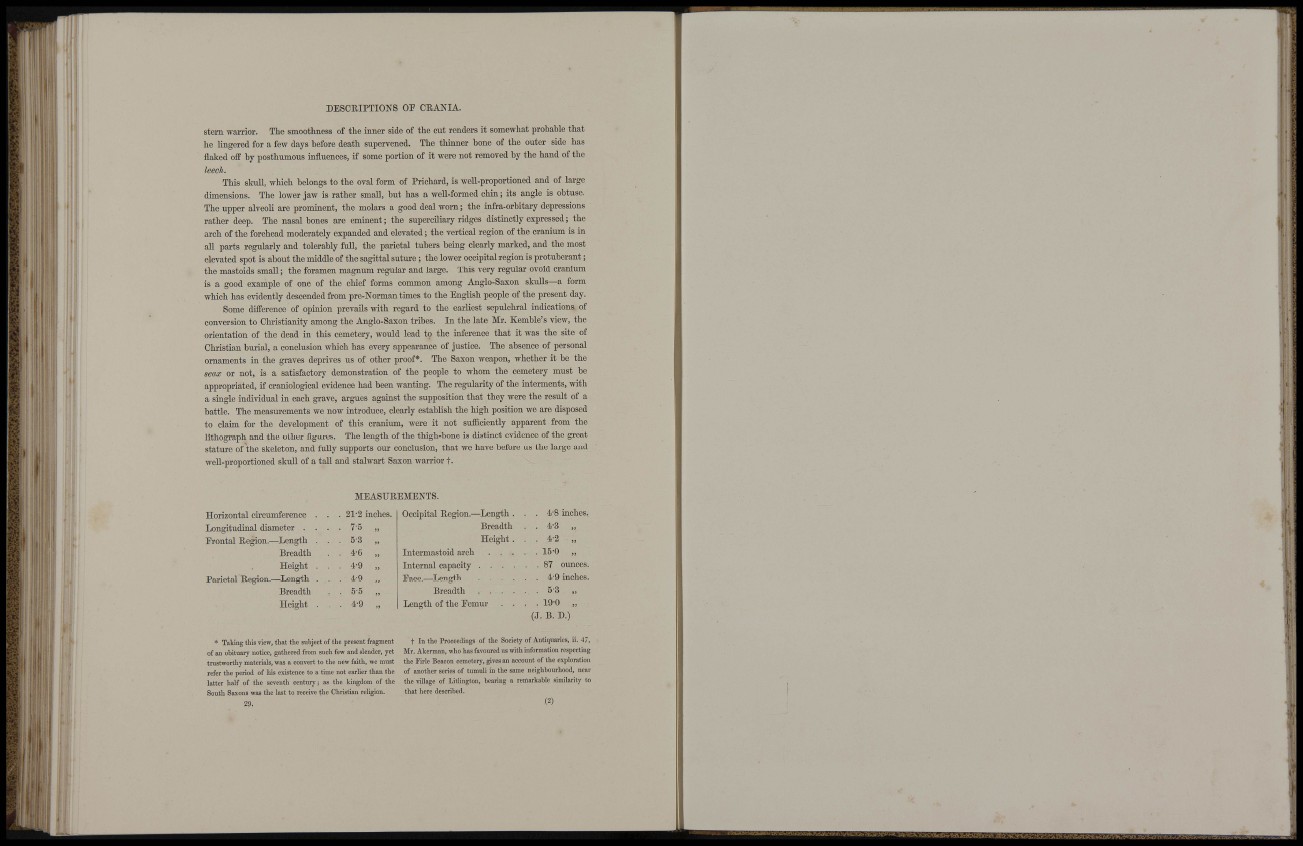
• m i !
.ini'i:
I
i li
• 1
I s
DESCRIPTIONS OF CEANIA.
stern warrior. The smoothness of the inner side of the cut renders it somewhat probable that
he lingered for a few days before death supervened. The thinner bone of the outer side has
flaked off by posthumous influences, if some portion of it were not removed by the hand of the
leech.
This skull, which belongs to the oval form of Prichard, is well-proportioned and of large
dimensions. The lower jaw is rather smaU, but has a weU-formed chin; its angle is obtuse.
The upper alveoli are prominent, the molars a good deal worn; the infra-orbitai'y depressions
rather deep. The nasal bones are eminent; the superciliary ridges distinctly expressed; the
arch of the forehead moderately expanded and elevated; the vertical region of the cranium is in
all parts regularly and tolerably fuU, the parietal tubers being clearly marked, and the most
elevated spot is about the middle of the sagittal suture; the lower occipital region is protuberant;
the mastoids small; the foramen magnum regular and large. This very regular ovoid cranium
is a good example of one of the chief forms common among Anglo-Saxon skuUs—a form
which has evidently descended from pre-Norman times to the English people of the present day.
Some difference of opinion prevails with regard to the earliest sepulchral indications, of
conversion to Christianity among the Anglo-Saxon tribes. In the late Mr. Kemble's view, the
orientation of the dead in this cemetery, woidd lead to the inference that it was the site of
Christian burial, a conclusion which has every appearance of justice. The absence of personal
ornaments in the graves deprives us of other proof*. The Saxon weapon, whether it be the
seax or not, is a satisfactory demonstration of the people to whom the cemetery must be
appropriated, if craniological evidence had been wanting. The regularity of the interments, with
a single individual in each grave, argues against the supposition that they were the result of a
battle. The measurements we now introduce, clearly establish the high position we are disposed
to clann for the development of this craniimi, were it not sufilciently apparent from the
lithogi-aph and the other figures. The length of the thigh-bone is distinct evidence of the great
stature of the skeleton, and fully supports our conclusion, that we have before us the large and
weU-proportioned skull of a tall and stalwart Saxon warrior +.
MEASUREMENTS.
Horizontal circumference . . 21-2 inches. Occipital Region.—Length . . 4-8 inches.
Longitudinal diameter . . . 7-5 „ Breadth . é-3 „
Erontal Region.—Length . . 5-3 „ Height . . 4-2 „
Breadth • 4-6 „ Intermastoid arch . . . . 15'0 „
Height . . 4-9 „ Internal capacity . . . . 87 ounces.
Parietal Region.—Length . • 4-9 „ Pace.—Length . . . . 4-9 inches.
Breadth . 5-5 „ Breadth . . . . 5-3 „
Height . . 4-9 „ Length of the Pemur . . . 19-0 „
: 1
'uI,
(J. B. D.)
lili
lil
i
. i! Li illiltl
1.1 ijl illll
[I ..r '
lÜ
í:lil!
t. - r.
I ii'
(1 iiiiij
li -i i 11'1 í
¡M
i" í
il
.ílf I
Jill i?
i
" - 1 ) 1 r
5; >
f "
* Taking this -view, t i a t the subject of the present fragment
of an obituary notice, gathered from such few and slender, yet
tnistworthy materials, was a convert to the new faith, we must
refer the period of his existence to a time not earher than the
latter half of the seventh century; as the kingdom of the
South Saxons was the last to receive the Christian religion.
29.
t In the Proceedings of the Society of Autiquaries, ii. A7,
Mr. Akerman, who has favoured us with information respecting
the Firle Beacon cemetery, gives an account of the exploration
of another series of tumuli in the same neighbourhood, near
the village of Litlington, hearing a remarkable similarity to
that here described.